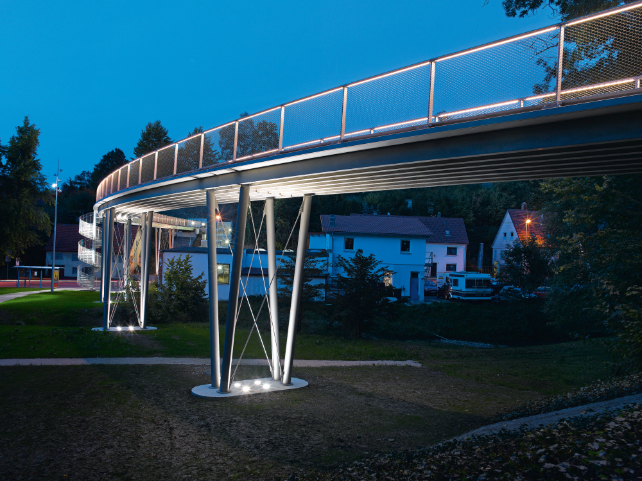Etiketler
Kasım 2010'da, tekstil takviyeli betondan yapılmış dünyanın en uzun köprüsü Albstadt-Lautlingen'de açıldı. Yeni yaya ve bisiklet köprüsü, yalnızca yaklaşık 30 yıl sonra onarıma ihtiyaç duyan eski betonarme köprünün artan güvenlik eksikliklerine yanıt olarak inşa edildi. Albstadt şehri , Groz Beckert (bu, Groz-Beckert'in kurumsal girişimi olarak solidian GmbH'nin kurulmasından önceydi) ve RWTH Aachen ile yakın işbirliği içinde yenilikçi bir çözüm geliştirildi: Aşındırıcı olmayan özellikleri sayesinde yalnızca 1,5 cm'lik minimum beton örtüsüne izin veren tekstil takviyeli betonun kullanımı, olağanüstü ince ve hafif bir yapının gerçekleştirilmesini mümkün kıldı. Yaklaşık 97 m toplam açıklığa ve yalnızca yaklaşık 43,5 cm üst yapı yüksekliğine sahip altı prekast elemandan oluşan köprü, modern malzemelerin ve hassas prekast yapının yapıların dayanıklılığını ve estetiğini nasıl sürdürülebilir şekilde iyileştirebileceğini etkileyici bir şekilde göstermektedir.
Teknik veriler
- Toplam uzunluk: yaklaşık 97 m
- Üstyapı yüksekliği : yaklaşık 43,5 cm
- Segmentasyon : 6 adet prefabrik parça (maksimum açıklık yaklaşık 17,2 m)
- İncelik oranı: yaklaşık 1:35
- Minimum beton örtüsü: 1,5 cm
- Beton kalitesi: Yüksek kaliteli ince taneli beton (dayanım sınıfı yaklaşık C50/60), özellikle yüksek donma ve aşınma direncine uyarlanmıştır
- Takviye: Alkaliye dayanıklı cam elyafı (AR cam), tam çekme mukavemetini etkinleştirmek için epoksi reçine ile önceden işlenmiştir
- Öngerilme: Yük kapasitesini artırmak ve ölü ağırlığı azaltmak için geleneksel monotellerin entegrasyonu
- Ek özellikler: Entegre LED aydınlatma sistemi ve çekici, zarif tasarım
- Hizmet ömrü: Yaklaşık 80-90 yıllık planlı hizmet ömrü
Challenges
Despite the numerous advantages, a number of challenges also arose during the planning and construction:
🟠Approval: Since textile concrete is still a relatively new material, there was no comprehensive normative regulation at the time of planning. The approval was therefore granted on an individual basis (ZiE), which required a great deal of coordination. Today, it is possible to plan and build bridges without a special approval in accordance with solidians national technical approval Z-1.6-308 and DAfStb guideline "Betonbauteile mit nicht-metallischer Bewehrung".
🟠Concrete quality requirements: Over time, slight freeze-thaw damage has appeared on the road surface, as well as small, longitudinal cracks outside the railings. However, these do not affect the load-bearing capacity and can be remedied by a conventional surface protection system. The damaged areas, which cover only about 2-3 square meters, were caused by challenges in the manufacturing process of the precast elements during surface-near concrete compaction.
🟠Maintenance work: As reported in current press releases, regular inspections (e.g. according to DIN 1076) and planned maintenance work (replacement of expansion joints, cosmetic repairs) are necessary to ensure that the excellent overall condition is also maintained in the long term. This is because the project was one of the first that where built with textile reinforced concrete. With now over 10 years of experience there is no maintanance work required for future projects.
The textile-reinforced concrete bridge in Albstadt Lautlingen is a pioneering pilot project that shows how modern material technologies can be applied in bridge construction. The innovative combination of textile-reinforced fine-grained concrete and prestressing not only enables an impressive, slender construction and an extended service life up to 100 years, but also provides valuable empirical data for future projects. Despite some challenges, the structure is in very good condition after more than 10 years of regular maintenance and inspection, thus underlining the great potential of this technology for the future.


